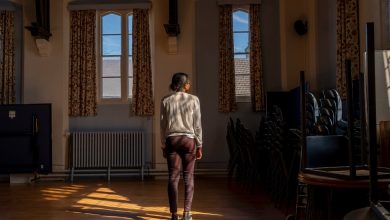Anne Parsons, Who Revived the Detroit Symphony, Dies at 64

Anne Parsons, who as president and chief executive revitalized the Detroit Symphony Orchestra in the aftermath of a bitter strike, using education and technology to attract new audiences, died on March 28 in Detroit. She was 64.
Her husband, Donald Dietz, said the cause was complications of lung cancer.
Ms. Parsons, who led the Detroit Symphony from 2004 until December 2021, shepherded the orchestra through a six-month strike that began in 2010, one of its most challenging periods. She worked to ensure that the orchestra emerged from what many considered a near-death moment, reassuring donors and civic leaders as tensions between musicians and management escalated.
Determined to avoid another labor dispute and eager to make the orchestra a pillar of Detroit’s civic revival, she spent the next decade rebuilding the ensemble, investing in live-streaming technology, expanding community programs and luring unconventional stars like Kid Rock to perform. At a time when many American orchestras were struggling amid declining ticket sales, the Detroit Symphony, digitally connected and agile, became a model modern ensemble.
“They hit a financial wall and went through a very brutal strike,” said Mark Volpe, who was president and chief executive of the Boston Symphony Orchestra for 23 years. “Instead of conceding and leaving like others have done in that context, she had the stomach, the persistence, the tenacity and, frankly, the vision to do something very special.”
Anne Hyatt Parsons was born on Nov. 4, 1957, in Schenectady, N.Y., to Gerald Parsons, who worked in finance, and Jane (Walter) Parsons, a schoolteacher.
She initially pursued a career in finance to please her father, working as a bank teller during her summers at Smith College.
But Ms. Parsons, who began studying the flute as a child, soon found herself drawn to the arts. She became manager of the student orchestra at Smith, helping keep it together during a time of discord about its role on campus.
She graduated from Smith in 1980 with a degree in English. She promised her father she would return to banking if, within one year, her career in the arts did not work out. But before long she had begun to ascend in the arts industry.
She was among the first class of fellows chosen by the American Symphony Orchestra League (now known as the League of American Orchestras). As a young employee at the National Symphony Orchestra in Washington, she served as an aide to the cellist and conductor Mstislav Rostropovich, who was the music director at the time.
She went on to serve in a variety of prestigious posts, including orchestra manager of the Boston Symphony from 1983 to 1991; general manager of the Hollywood Bowl in Los Angeles from 1991 to 1998; and general manager of New York City Ballet from 1998 to 2004.
When she arrived in Detroit in the summer of 2004, she faced immediate challenges, including a sharp decline in ticket sales and dwindling support from corporations. She worked to overhaul the orchestra’s offerings, and in 2008, in a coup, she lured Leonard Slatkin, then the music director of the National Symphony Orchestra, to take the podium in Detroit.
As Detroit’s economy worsened amid the Great Recession and the orchestra’s financial picture grew bleaker, tensions at the orchestra escalated. A strike erupted in October 2010 after the orchestra, citing the difficult economic environment, proposed steep reductions in pay and benefits. The musicians said the cuts would destroy the ensemble’s high caliber, and they led a spirited campaign to oppose them.
Ms. Parsons maintained a tough stance throughout the ordeal. “The board was telling her, ‘You’re going to be the bad guy,’” Mr. Slatkin said in an interview. “But that’s the role, that’s the job. And there were days when I don’t know how she managed it. It became very, very vicious. But she stuck it out and kept a positive attitude the whole time.”
After six months of heated talks, a deal was reached. In the end the players accepted large salary reductions but preserved their health insurance and pensions.
In the aftermath of the strike, Ms. Parsons set out to find ways to elevate the orchestra’s profile and bring in more revenue. She began a streaming service, one of the first orchestras to do so, and organized tours abroad, including to China and Japan. Vowing to make the Detroit Symphony the “most accessible orchestra on the planet,” she also oversaw efforts to expand music education in the city, bringing orchestra players into public schools that served large numbers of poor families. She also increased the orchestra’s presence in the suburbs, where many of its patrons live, holding concerts in churches, high schools and community centers.
Donations rose, and ticket sales began to bounce back. After running deficits for years, the orchestra reported operating surpluses from 2013 to 2021.
“What I really felt was this incredible responsibility to find a way forward regardless of the challenge that was facing us,” Ms. Parsons told The Detroit News last year. “The alternative for an institution as storied as the D.S.O. was unacceptable to me.”
Even some of the musicians who clashed with Ms. Parsons during the strike said she had been vital to the orchestra’s turnaround.
“After the strike, she said, ‘We’re never going to do that again. We have to maintain the artistic quality of the organization,’” said Haden McKay, a former cellist in the orchestra who served on the negotiating committee during the strike. “It was a stake in the ground. It put the institution on good footing, both financially and psychologically.”
Ms. Parsons called her move to Detroit with her family the “best decision we ever made.” In 2021, the city named a street just south of Orchestra Hall in her honor.
In addition to her husband, a photographer, Ms. Parsons is survived by a brother, Lance Parsons, and a daughter, Cara Dietz.
Ms. Parsons learned she had lung cancer in 2018, but despite her illness she kept a busy schedule. She stepped down two months after returning from an extended medical leave.
“She wanted to be able to say she’d given everything she could give,” Mr. Dietz said. “And that’s what she said to me after she couldn’t do it anymore. She said, ‘I have nothing else to give.’”
Ms. Parsons said last year that her illness had brought into focus the “fragility of our world.”
“We just take for granted that we’re going to be healthy and one day we’re not,” she said in an interview last year with Crain’s Detroit Business. “We take for granted someone is going to be a strong leader. When that doesn’t happen, it causes you to wake up every day and be grateful for the positive things.”





